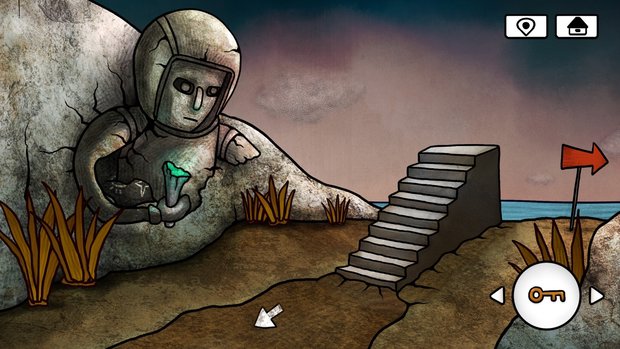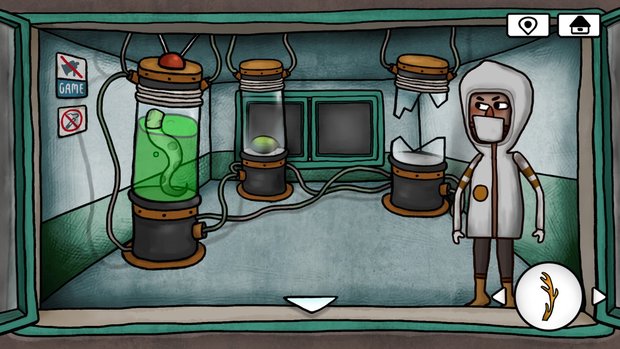ISOLAND4: The Anchor of Memory review

- 0 Comments
I imagine there’s a good chance you’ve never played an Isoland game from little-known developer Cotton Game. The indie studio’s penchant for uniquely surrealist puzzle adventure games represents a specific style that’s hard to find anywhere else and may perhaps be something of an acquired taste. This is a review for the latest game, ISOLAND4: The Anchor of Memory, which is actually the fifth game in the series, but it’s difficult to talk about the game itself without talking about the franchise as a whole. The games have a tone and set of themes that carry across all five, similar to the way that the Cube Escape/Rusty Lake games do, and to play one is to dip into a sea that contains them all. Thus, there is no perfect place to start, but The Anchor of Memory will give you a good sense of the series’ challenging, often abstract puzzles, quiet and thoughtful ambience, and unique 2D hand-drawn illustration.
The highly atmospheric Isoland games are puzzle-centric point-and-click adventures. The Anchor of Memory starts in outer space, but then quickly transports you to a house full of odd rooms, like a field full of street signs, a forest, and a science lab. You explore these rooms, solve puzzles, and eventually you exit the house, out into the world where you find a crashed spaceship and a temple – both characteristic of all Isoland games – and some other unique landscapes. There is always another challenge to solve, but you never feel like you’re on any kind of defined “quest.”

You play as a disembodied first-person character who has no dialogue, no personality, and no arc. The “plot,” in the loosest sense of the term, is that you’re walking scene to scene through a surreal world, encountering characters who all need something and usually have some philosophy or song lyrics to share with you. A man in a turban tells you the lyrics to Nirvana’s “Come As You Are” in between asking you for four distinct objects that he’ll need to achieve a higher meditative state. Your goal, then, is to seek out all four of those objects, often scattered around the world or hidden behind a puzzle. Upon you returning and placing them in the correct order (which you might learn from a clue somewhere else), he will give you an item to take elsewhere.
Major story beats are often heady and obscure, and characters serve more as obstacles to progress than fully integrated elements. They’re on personal journeys ranging from small (they lost their remote control) to large (they need to escape this dimension to voyage into the stars), but each is treated with equal weight. Often they begin with a line of dialogue (“I wish I had something to read”) and end with an animation (a man piloting a rowboat through a portal in the wall) and there is little follow-up or explanation. Each event seems disconnected but generally serves some larger theme like loneliness or finding one’s place in the world. If you’re looking for a coherent story rather than poetic metaphor, Isoland is not the place to go.

The challenges are largely focused on pattern recognition, logical intuition, and memory. Inventory puzzle solutions are often closer to “this object looks somewhat similar to that statue; let’s try to use them together” than figuring out unconventional uses for everyday objects. For example, the only thing that may indicate that a particular green rock goes on a certain pedestal is a light green glow on the pedestal’s base. However, there are occasional instances of more classic point-and-click adventure solutions. For instance, if a shovel can’t get a treasure out of a hole in a rock, what other object in your inventory might?
Such puzzles are at the heart of each game and are often clever but are sometimes, honestly, completely obtuse. Isoland games are at their most successful when they are testing your ability to reason, and at their least successful when they require trial and error. Thankfully, ISOLAND4 avoids the latter much more than previous entries. There is generally a clue as to what you need to do located somewhere in the world, and it is your job to find it.
The game is also chock full of logic puzzles, such as a series of switches that turn on but also turn off others, and your goal is to work out the correct sequence to have them all on at the same time. Another thing you might find is a combination lock with a particular image on it, and you must interpret from that image where in the game you should go to find the correct number, much like an escape room. This type of puzzle design works best when the clues are cryptic and solutions aren’t simply spelled out. Copying down a series of symbols in one room to take to another room and inputting them into a machine verbatim can be an unfulfilling experience.
While the puzzles are a bit of a mixed bag, the major thing ISOLAND4 excels at is tone. The entire game holds a sense of both serenity and mystery. Many characters are pondering questions that have no answers: existential quandaries about the nature of life or simple inquiries about where they are and why. While many of these questions still aren’t answered by the end, the characters often find acceptance and peace with the answers they don’t have. A feeling of loneliness is replaced with memories of love. Characters learn to accept their new lives or find meaning in something much smaller than the large questions they are asking. While this is achieved based on something simple, like giving a photo to a woman or playing a song for a man, they are no less moving. Reading through the aphorisms each character has to impart can be pretty life-affirming.

This meditative feeling that pervades each Isoland game – and is of course present again here – is helped along by the soundtrack. Relaxing synthesizers, pianos, or strings are a constant companion in your travels. The games are all effective at delivering calm through their music, without sacrificing the eerie ambience of mystery. Accompanied by the satisfying clicks of buttons or use of inventory items, and ambient atmospheric sounds such as a crackling fire, a bubbling pot, or metal signs creaking as they sway gently in the breeze, ISOLAND4 is particularly effective at creating tableaus that instill feelings of isolation, sadness, serenity, or other quiet, low-key emotions.
The artwork is all heavy black lines, creating simplistic scenes filled in with lovingly painted textures. At first glance, the characters may look clumsy and the backgrounds fairly plain. However, the more you play, the more this style really deepens the mood of alternating eeriness and comfort. The main word I’d use to describe the art in Isoland is “intentional.” Nearly every detail in every scene is put there for some purpose – either literally, meaning they are placed there to help you progress, or metaphorically, as in drawings or words that emphasize a philosophical point. The style itself combines exaggerated cartoonish perspective with simple, spacious locales. It’s almost as if Pablo Picasso drew for Nickelodeon Magazine in the 1990s.
I understand this all sounds very heady and metatextual, but that’s the deal if you’re going to enjoy an Isoland game. I suppose you could play one simply for the puzzles, but if that’s what you’re after, you might be better off getting one of the thousands of escape room games on the market right now. Isoland is about slowing down and sitting in your thoughts for a moment while you solve strange enigmas. It’s about engaging very reflectively with music and literature and philosophy and science. Sometimes, in one of these games, an album cover or a name, like “Newton” or “Kierkegaard,” will just be written on the wall and you’re expected to ponder that person’s ideas while you navigate the next challenge. It may not even help you solve the puzzle, but it will help you enjoy the game.
If you’re up for that sort of thoughtful, artsy experience, then ISOLAND4 is a pretty good place to start. You need no knowledge of previous installments to enjoy this one, and The Anchor of Memory is far from the most challenging game in the series. I breezed through it in just under two hours, but as you’ll learn, you always want to experience an Isoland game at least twice. As you play through again, you’ll find some puzzles have gotten a bit more complex. Certain characters are on slightly different parts of their journeys. A handful of rooms are slightly rearranged. New achievements are available. And often a different ending awaits you on a second playthrough.
Final Verdict
I would suggest playing ISOLAND4 like you’re visiting an art installation, but with puzzles to solve. There are many scenes and lines of dialogue to sit with and muse over, rather than a story that is going to pull you along with its twists and turns and thrilling scenes. The puzzles range from good to overly abstract, the soundtrack is amazing, and the art is incredible, albeit evoking a very particular aesthetic. The Isoland games may not be for everyone, but if they do suit your sensibilities, The Anchor of Memory is going to hit very well and potentially open up a gateway to a world of similarly surreal puzzle adventures from this developer.
Hot take
The Anchor of Memory, like all Isoland games, is a unique experience that will appeal to a player's quiet, thoughtful, poetic side. Light on story and heavy on bizarre puzzles, this game lives up to its predecessors in every way, making it a solid addition to the franchise.
Pros
- Thoughtful themes and ideas emanate from dialogue and scenery
- Stylized art sets an effective tone between classic and cartoonish
- Atmospheric score and sound design
- Chock-full of puzzles of varying difficulties that will keep you moving and challenged at the same time
Cons
- Very little story, and what’s here is fairly bewildering
- Some puzzles are too simple, while some are too esoteric, requiring guesswork
Matt played his own copy of ISOLAND4: The Anchor of Memory review on PC.











0 Comments
Want to join the discussion? Leave a comment as guest, sign in or register in our forums.
Leave a comment